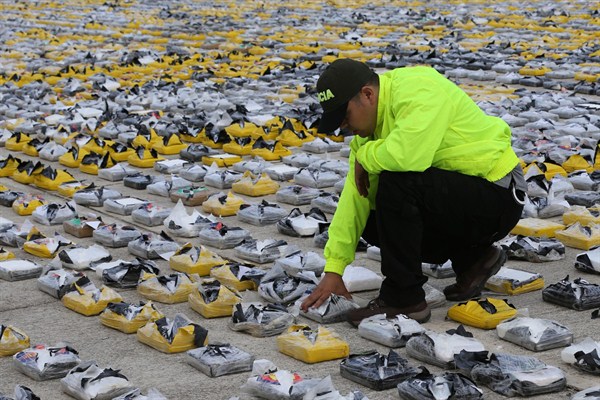The latest figures released by the United Nations indicate that Colombia has retaken the title of world’s largest cocaine producer, with some 69,000 hectares of land used for growing coca. After years of declining production, the U.N. estimates cocaine production in Colombia will increase by 52 percent this year.
Only two years ago, Peru overtook Colombia as the top producer of coca and processed cocaine, as Bruno Binetti and Ben Raderstorf explained in their WPR feature this week. “Unlike most of its neighbors, Peru lacks a comprehensive strategy to fight drug trafficking, instead preferring to downplay the issue . . . Moreover, police corruption is well-documented, and initiatives to reform the security forces have been sporadic and ineffective.”
In Colombia, on the other hand, there is a strategy to fight drug trafficking: Plan Colombia, a U.S. military and diplomatic initiative targeting drug cartels and insurgent groups. But as Adam Isacson wrote last month, U.S. aid to Colombia and Plan Colombia will have to be recalibrated if a peace deal with the guerilla group known as the Revolutionary Armed Forces of Colombia, or FARC, is reached:
Keep reading for free!
Get instant access to the rest of this article by submitting your email address below. You'll also get access to three articles of your choice each month and our free newsletter:
Or, Subscribe now to get full access.
Already a subscriber? Log in here .
What you’ll get with an All-Access subscription to World Politics Review:
A WPR subscription is like no other resource — it’s like having a personal curator and expert analyst of global affairs news. Subscribe now, and you’ll get:
- Immediate and instant access to the full searchable library of tens of thousands of articles.
- Daily articles with original analysis, written by leading topic experts, delivered to you every weekday.
- Regular in-depth articles with deep dives into important issues and countries.
- The Daily Review email, with our take on the day’s most important news, the latest WPR analysis, what’s on our radar, and more.
- The Weekly Review email, with quick summaries of the week’s most important coverage, and what’s to come.
- Completely ad-free reading.
And all of this is available to you when you subscribe today.

